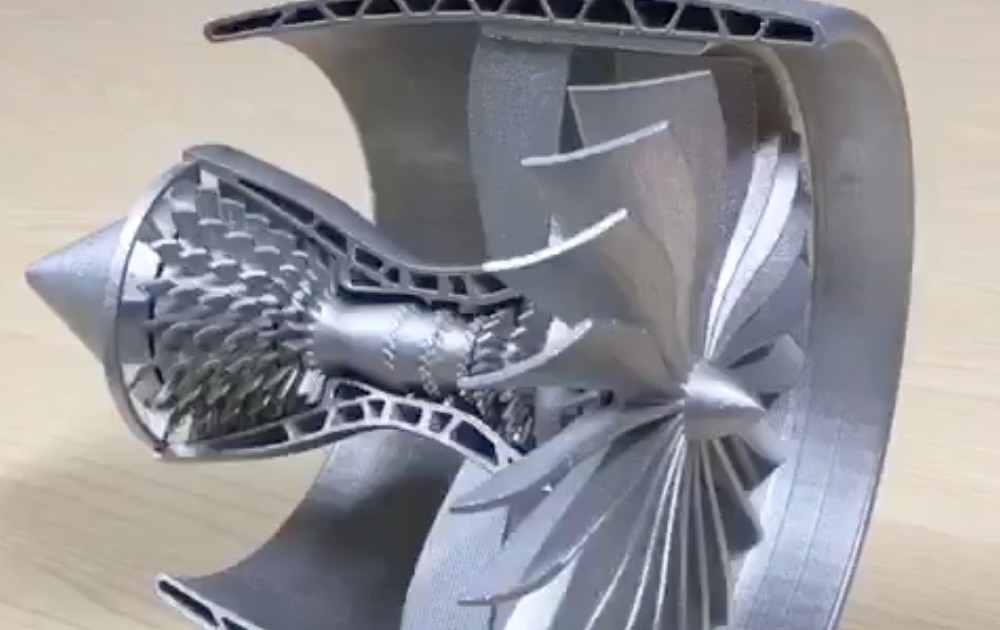Professor Moataz Attallah is the director of the University of Birmingham’s specialist Advanced Materials and Processing Lab, known as AMPLab.
Additive manufacturing from the AMPLab is behind of some of the most cutting edge materials research in the 3D printing industry, including a 3D printed ceramic thruster, that achieved “unprecedented results,” and a machine that can 3D print metal in zero gravity conditions.
In this interview 3D Printing Industry find out more about Professor Attallah’s current projects with the European Space Agency, 3D printed implants that can deliver precise doses of medicine and how AMPLab is breaking down barriers to 3D printed progress.
3D printed turbine engines
From his office at the University of Birmingham, Professor Attallah speaks passionately about his past projects, often getting up from the desk to show me a working component, like a model turbine engine, and buttons made from new mixtures of metals.

To start he speaks about the rise in 3D printed components for turbine engines. For that work AMPLab collaborated with Monash University to 3D print components for their engine. Professor Attallah explains,
You cannot really print an [entire] engine. Even if you look into that engine they printed and tested, that was primarily an engine designed for short range applications
He continues to talk about the 3D printed turbine blades developed by Siemens used to generate energy,
Land turbines are completely different from aero engines. If things fail on the ground that’s fine, you can mitigate that, you can fix that. But if things fail in an airplane, you can’t really fix that. You can’t park somewhere, or call the AA to fix it. So it’s not that easy.
The key for the AMPLab is starting small and working its way up,
We start from powder studies, to understand its properties, and we build a small component, and then eventually a bigger part like a like a plate to prove the concept.
A single project typically goes, “From the concept development, the material development, to the actual product, within the lab, within someone’s PhD.”
In addition to, turbine research the European Space Agency, headquartered in Paris, France and founded in 1975, granted AMPLab €1 million to develop a method to accelerate the discovery of new metal alloys for industrial use.
New 3D printable metals
The grant is part of a €22 million (Over $23 million USD) partnership between 31 industry partners including the UK’s Renishaw, Rolls Royce, and car manufacturer Fiat’s research center.

All rights reserved
University of Birmingham Alumni
“Currently,” Attallah explains “when you develop a material (especially a metal material), it may take you something like 5 years to prove that this material is useful,” and so the AMPLab idea is to accelerate this process.
Now at completion, the ACCMet (Accelerated Metallurgy) project feeds metal wire feedstock into a mode of direct laser fabrication (DLF). The process creates small buttons of the alloy in a process that lasts 2 minutes. These buttons can then be tested for the required properties and, if successful, the experiment is scaled up.
The ACCMet machine is poised to create a shift in the metals materials available for additive manufacturing. As Professor Attallah points out,
Really every new material has the potential to make a Nobel Prize you know. If you can make everyday something like 80 new materials, we’re likely to find another material that’s going to win
3D printed implants that leak medication
After aerospace, medicine is another of AMPLab’s key focuses.

In one particular project, Attallah and his team combine the concepts of 3D printed pharmaceuticals with well-developed metal implants to “leak” antibiotics into the body.
Taking a hip implant for example […] Instead of making it solid, we’re going to open a channel inside so it’s a hollow implant. We put antibiotics or anti-inflammatory drugs inside and as a person walks it’s going to start leaking.
The goal is to provide localized treatment at the point of infection, though it the concept is still at an early stages.
Barriers to progress
In our interview, Attallah tells me that one of the main obstacles for additive manufacturing at the moment is not having the researchers available to make the breakthroughs. On completion of their degree many students are reluctant to stay as academics and instead opt to enter the industry.
To remedy this, the University offers PhDs for the specialist study of additive manufacturing. The research projects led by Attallah are to optimize the control of 3D printing processes, particularly in temperature control for blown powder additive manufacturing,
That process is not that smart. And it’s control is very complicated. When you’re building components like that, one problem you always see is that the component is going to experience distortion […] Once you take it out of the machine it’s going to curl up like a banana straight away.
We’re trying to design how the material is going to be melted, trying to model that distortion, and get the machine to figure out that there might be a problem there.
You can stay up to date with the research by following the University of Birmingham’s AMPLab, or Professor Moataz Attallah, on Twitter.
3D Printing Industry will be keeping our subscribers updated too. You can sign up to our newsletter here, or follow us on Twitter. We’d also like to hear more about additive manufacturing projects. Email 3D Printing Industry here.
Featured image shows Professor Moataz Attallah, metallurgist and director of the AMPLab Photo by Edward Moss. All rights reserved University of Birmingham Alumni.



